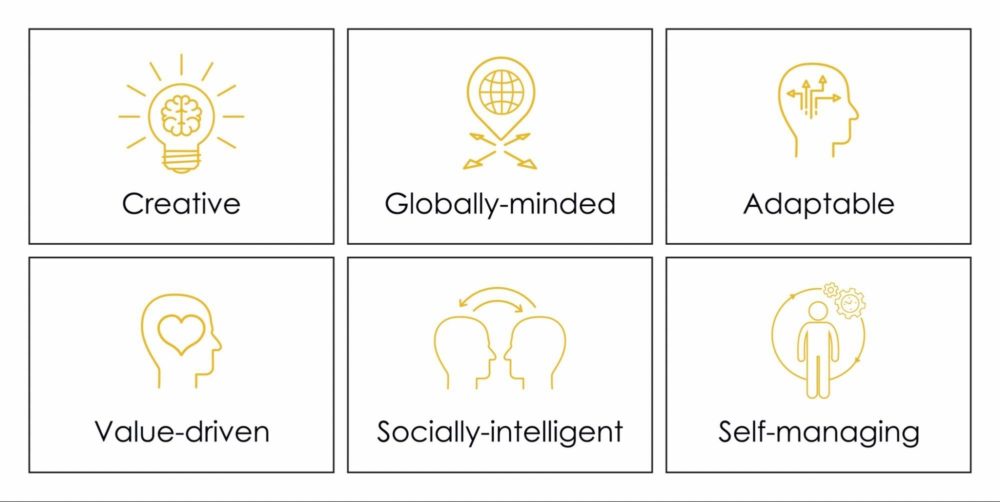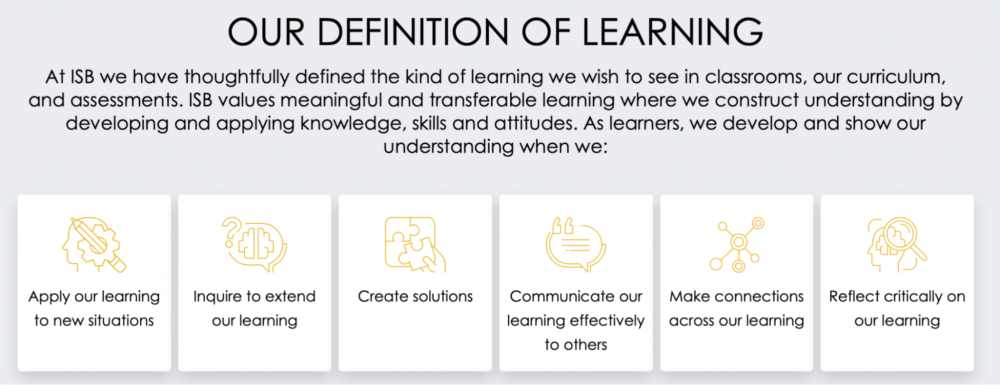Mission in Action: How Teaching for GOA Benefits Home School Communities
When the GOA team speaks with schools that are considering joining our global consortium, the focus is often on the passion-based courses offered through GOA’s Student Program and the access member schools have to GOA’s Center for Professional Learning. A benefit of membership that is less often discussed, but which many of our member schools employ, is the opportunity for teachers at member schools to teach for GOA. The International School of Bangkok (ISB), a GOA member school since 2020, currently has four teachers teaching for both GOA and ISB. The courses they teach at GOA range in topics from Introduction to Investments to Graphic Design to Entrepreneurship in a Global Context.
The mission of ISB focuses on outstanding teaching and learning and developing students to be passionate, reflective learners and caring global citizens. GOA’s mission, to reimagine learning to empower students and educators to thrive in a globally networked society, similarly centers on the idea of global citizenship and high-quality teaching and learning. Transferable learning is at the heart of ISB’s tailor-made curriculum allowing students to transfer their learning from one context, and continent, to another as easily as possible.
“The opportunity to partner with GOA fits in very well with our vision, mission, and learner attributes,” wrote Justyna McMillan, Dean of Academics, in ISB’s initial application for membership. This mission alignment is something that GOA looks for when connecting with prospective member schools. If the mission alignment is clear from the outset, it is more likely that a school will engage deeply with all that membership has to offer - from student courses to professional learning, to extending the opportunity to teach for GOA to their faculty. “When we think about mission-appropriate learners and learning, we must think about our entire community as learners. The opportunity to teach for GOA gives students and teachers access to personalizing their learning interests, reflecting on who they are as learners, and identifying and acting upon meeting their learning needs,” said Jennifer DeLashmutt, Director of Curriculum and Professional Learning at ISB.

International School of Bangkok's Learner Attributes
GOA currently employs over 100 teachers to deliver the 50+ courses in GOA’s student program. The overwhelming majority of these teachers come from GOA member schools. When a teacher is hired by GOA, they engage in over 70 hours of training on online course design, facilitation, and competency-based learning. They are then paired with instructional coaches who encourage and support them throughout their time with GOA. These teachers become part of a global network of educators who communicate regularly to discuss best practices in teaching and learning, current events, and ways to best support students. For GOA member schools like ISB, this means that their teachers who also teach for GOA are highly trained, deeply supported, and able to “bring home” important new skill sets that they can then cascade to their peers.
Below are three lessons that ISB teachers working with GOA have brought home to ISB and how they are mission-aligned.
Proficiency with online course design and a reframing of time and space
When ISB first inquired about GOA membership, the COVID-19 pandemic had not yet taken hold across the globe. As the situation escalated and the school was required to switch to virtual learning, ISB found that their teachers who were working with GOA had developed critical skills in online course design that benefited their broader community.
ISB teachers have been empowered to explore new ways to design courses and to experiment with the platforms used in both their in-person and online courses. “One project we have been working on at ISB is the development of an online Thai Language and Culture series of modules. One of our GOA faculty members partnered up with the Thai Language and Culture team in order to co-create these modules for our newly admitted students and families entering Thailand,” shared Jennifer DeLashmutt.
Teacher Matt Piercy adds, “Teaching for GOA has helped solidify my beliefs about learning and the nature of building relationships. We are not to be limited to in-person learning and yet, this time is ‘the gold.’ I have begun to think much more about what makes the most sense in a physical setting. One example is how I have largely phased out pencil and paper, opting for the creation of a digital notebook.” In this statement, Matt exhibits one of GOA’s educator competencies - namely, the ability to rethink time and space.
Reinforcing key tenets of competency-based learning
One of the central goals of competency-based learning (CBL) is agency, or allowing students to have a voice and choice in what and how they learn. All GOA courses are aligned to a CBL framework, with each student progressing towards mastery of specific competencies during their course. GOA’s competency-based approach is aligned to ISB’s definition of learning, and ISB teachers who teach for GOA learn new ways to support students’ development of key competencies including communication and collaboration, independent learning, and critical thinking skills.

International School of Bangkok's Definition of Learning
ISB teacher and GOA Graphic Design teacher Jacob Ortwein shares, “Competency-based learning is one of the strong factors in GOA. Students understand these competencies and perform based on them. We try to replicate this same method with our rubrics in our design class at ISB.”
Because most of the coursework for a GOA course is asynchronous, students also learn valuable time management and independent learning skills. According to Jacob Ortwein, “Students need to organize their own time and do the work themselves. We take for granted that students show up to class and get instructions from teachers, but at GOA students need to make the effort to engage in discussion and complete assignments on their own. This is a hugely important skill to learn, taking initiative and GOA's online courses encourage this self-management.”
Through their training with GOA, ISB teachers are also shown the benefits of allowing students to co-design their learning experiences. GOA’s Associate Director of Professional Learning Becky Green wrote in a post from last spring, “Co-designed learning means that students are equipped with the environment, skills, and structures for taking active, empowered roles in working towards relevant learning targets. Students know themselves as learners, know their interests, and know how to strategically pursue their own learning pathways.” Matt Piercy wrote that after completing a professional learning experience with GOA, he “shared with colleagues [his] desire to begin an intentional transition from teacher-designed to co-designed learning.”
Creating a culture of feedback
At GOA, we believe deeply that feedback is a powerful tool for supporting student learning outcomes and cultivating community. When we talk to GOA teachers about the importance of feedback, we stress that written feedback is only one piece of the puzzle. We encourage our teachers to opt for video feedback, especially early in a semester, because of the warmth they’re able to communicate. There are a plethora of online tools, including platforms like Loom and Flipgrid, that can be used for video feedback and GOA teachers put many of these to use with their students. When thinking about how his GOA training has impacted his teaching at ISB, Matt Piercy shared, “Continual creative adjustments are being made. Most noticeably, in the variety of feedback I provide. I am also more regularly inviting students to provide different formats of giving and receiving feedback.”

In the images above, Matt shows two examples of how he has utilized both video and text feedback to connect with a student. The video feedback adds a personal touch and fosters a deeper sense of connection and care. The second image is of a standard feedback rubric, along with a personal narrative explanation. In the images below, Matt shares an example of peer-to-peer feedback through an asynchronous discussion platform. These two students, located in Philadelphia, USA and Bangladesh, are able to build connections and share ideas despite being located on opposite sides of the globe.

GOA and ISB share a commitment to developing globally-minded, self-managing, and adaptable students. Through their work with GOA, ISB teachers receive extensive training and support that empower them to explore new technologies and approaches to help students develop these important competencies.
This post is part of our Missions in Action series, which profiles how GOA member schools align GOA’s student and professional learning programs to meet their school’s mission. GOA member school students have full access to our online courses and member school educators can take our professional learning courses for free. Inquire about membership. Are you a GOA member? Want us to profile your school? Email us at hello@globalonlineacademy.org.
To learn more about ISB, visit their website.
